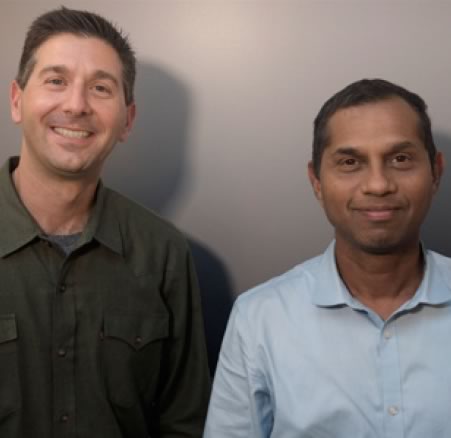In his new book Thank You For Being Late: An Optimist’s Guide to Thriving in the Age of Accelerations, New York Times columnist Thomas L. Friedman (The World Is Flat) discusses the fast-moving forces upending the world – technology, globalization and climate change.
Similarly, much is happening quickly in the VFX cosmos. VFX Voice caught up recently with industry veterans for a worldwide virtual Q&A Roundtable discussion about changes in the visual effects production universe. They include:
Jim Morris, VES, General Manager and President of Pixar Animation Studios; Sam Nicholson, Founder/CEO Stargate Studios; Anthony Hunt, Cinesite Group CEO; Dan May, President, Blackmagic Design; Alex Mahon, CEO, Foundry; Andrew Bly, CFO/Executive Producer, The Molecule; Neishaw Ali, President/Executive Producer, Spin VFX; Devin Sterling, VP Global Operations, Long Form, Deluxe Creative Services; Sébastien Moreau, President of Rodeo FX; Weyron Henriques, Director of Software Development, Deluxe Creative Services; Jacki Morie, Founder and Chief Scientist, All These Worlds, LLC; Neville Spiteri, CEO and Co-founder, Wevr; David Stinnett, Co-founder, Blur Studios; Ed Ulbrich, President and GM of VFX and VR at Deluxe; Pierre Raymond, President, Co-founder and Head of Operations, Hybride; Andrea Block, CEO and Producer, LUXX Studios; Adam Stern, VFX Supervisor/Owner, Artifex Studios; Namit Malhotra, CEO, Prime Focus World; and Parvinder Bhatia, Head of Entertainment, Plowman Craven.
Q: Given the sweeping importance of visual effects in all media production, how do you see the model for production of VFX evolving in the future? In other words, will traditional VFX facilities persist in some form, or do you envision some other model will emerge?
Morris: The visual effects world has changed dramatically over the past couple of decades. Unbelievably so. Digital approaches have almost entirely supplanted the photochemical techniques (motion control, miniature shooting, optical compositing, etc.) that were at their height when I joined Industrial Light & Magic in the mid-’80s. And the number of people working in effects has probably grown 20 fold.
The growth of the effects-fueled tent pole film has grown explosively as well. Once upon a time, a 350-shot show was considered a huge one, and there would only be a couple of those a year. Now there might be 20 films each having one to two thousand shots. And the quality of the work is staggeringly good.
But I’m not sure the basic model of effects production has changed that much. Yes, once upon a time a visual effects facility like ILM might do the effects work in an entire film all by itself. Given the size of films now, and the fact that many shows have production-side effects supervisors and producers to oversee the show’s vendors, single facility shows are a rarity.
But there have always been small, medium and large shops out there doing effects work. Now there are just more of them. And each of them plays a valuable role in the filmmaking process. And while small shops can do an awful lot these days, projects of huge scope, scale and variety still rely on the pipeline and capacity of the larger shops, as they always have.
Visual effects of superb quality are now common in television work, games, VR and attractions as well as in cinema. It is a vibrant industry that has bulked up on steroids, and while its sheer size makes it seem new and different, I think much of its underlying DNA is still the same, and the model that has been with us since ‘Star Wars’ persists.
Nicholson: Today’s VFX business model will continue to evolve as we respond to the ever-increasing creative demands and the rapidly evolving technologies which are reshaping media production and distribution. Tomorrow’s VFX business model will be less centralized, more collaborative and more globalized, offering limitless scalability and extreme horsepower at a reasonable price.
We are developing this business model into a very diverse group of internationally-networked artists with unlimited access to extensive cloud- based software and off-site rendering. Challenging VFX work deemed impossible today will be achieved by virtual communities of decentralized yet integrated artists networked through efficient digital delivery pipelines to meet the demands of tomorrow’s media.
Ali: VFX facilities will persist in the foreseeable future because visual effects is all about creating and achieving the director’s vision. This unique challenge cannot be commoditized or ‘manufactured’ and is often prone to subjectivity, as we try to create the ‘impossible’ – that which cannot be achieved in camera. As always it is a team sport and requires creative talent and a group of experienced knowledge-based team members through all facets of production from prep to post.
A successful production is one that has a reliable pipeline that can operate at the speed, volume and quality level demanded by clients and even more importantly a collection of experienced core-talented artists capable of synergistically deconstructing very complex creatives, technical directors that can script solutions at a moment’s notice, and experienced producers that understand the strength and challenges of the team and can mitigate the production’s liability. This is not something that can be organized or achieved within weeks of a project being green lit.
Newer tools will continue to allow artists to do more faster. Cloud computing is lowering barriers to entry on the cost and technology side and, the talent pool is growing internationally. So those trends may appear to favor decentralization and that may well exist in one form or another. However, in order to continue to innovate and reshape our industry, we need critical mass of resources working together to allow for creative invention and the development of new techniques as we continue to pioneer into the ever-evolving, challenging and inspiring creative marketplace that we work in.
May: The stakes have been raised for VFX and post professionals. In today’s landscape, they have to do more in less time. There are new consumption platforms (streaming, mobile, etc.), new standards (the jump from SD to HD and beyond with 4K/Ultra HD), and new technology and systems (high frame rate, high dynamic range, etc.) to keep up with. This all means that siloed workflows are no longer viable for today’s VFX facilities.
Collaborative workflows are now crucial because they allow post professionals across disciplines to work together in tandem on the same project or even the same shot, regardless of if they are in the same suite or different studios across the world.
Collaborative workflows require an interoperable and flexible toolset so the VFX artist, editor, colorist, etc. can seamlessly interface with each other without time-consuming round-tripping or any of the other pitfalls that can add time rather than eliminate it. These toolsets are critical as post professionals expand their skill sets to help with various parts of the post process that typically were outside of their purview – for example, VFX artists using color grading software to color correct VFX plates, or editors using VFX software to enhance actors’ performances when cutting together scenes.
VFX facilities need to invest in and build collaborative workflows that empower their VFX artists and breed creativity as they step outside their comfortable zones and take on new skills. This will help them remain competitive as the VFX production model continues to evolve.
Mahon: Technology advancements will shift the concept of ‘VFX facilities’ in the years to come. The sheer amount of data required for VFX and post-production work has meant that film companies have become adept at producing their own network facilities to manage it. However, cloud technology is now reaching the point where the advantages it offers, such as scalability, beat the question of its cost.
As the media production industry adopts cloud tools, you’ll see smaller studios and production houses become far more competitive with the big names. Previously, small outfits were held back by affordability to engineer their own cloud and data storage, an issue that cloud adoption removes. Now they can take on certain parts of a film project, for example, just by scaling up their cloud needs for that specific piece of work. As a result, you’re going to see a higher quality of competitive work from smaller operations, as they are able to produce the same level of VFX content that features in Hollywood blockbusters.
We recognize the benefits this type of technology can offer the industry, and are already looking at a project that would enable anyone – whether it’s a small studio or a single artist in their own home – to access a well-equipped VFX facility through a web browser. This is the power that cloud offers our industry, and the great news is that it will only improve the quality of VFX work that is undertaken over the coming years.
Hunt: Envisaging the future of the VFX industry is always a challenge. Technology is constantly changing, as are the VFX location hotspots. At this moment in time, a truly worldwide post production industry exists, fueled in part by an explosion in big-budget comic book and sci-fi films, animated features, and TV visual effects, but bigger does not always mean better. Mid-sized facilities will prosper if they focus on some key principles: people, projects, pipeline and partners.
People should be the priority and the core of studios. They are the talent behind the tools, and while there are many similarities between the global VFX houses, the cultures and environments differ.
We have a company culture that supports our crews and helps them develop into the best artists. This sounds simple and obvious but it’s incredibly important to keep at the forefront of all our operations.
By having both a service and IP approach a studio can put a stamp on the big, fun blockbusters, but also tell more rich and complex stories. Tellingly, Cinesite is working on Otto Bathurst’s first studio feature film with Lionsgate ‘Robin Hood: Origins,’ after having recently completed work on ‘Assassin’s Creed’ for Fox and ‘Fantastic Beasts and Where to Find Them’ for Warner Bros. This neatly demonstrates the wide range of VFX projects we’re now working on. This runs alongside our increasing feature animated content, including our four-picture deal with 3QU Media on films such as ‘Gnome Alone’ in addition to service contracts with big studios like Sony Pictures Animation, who we’ve partnered with to bring ‘The Star’ to the big screen. Development of our animation slate is also well underway.
Project variation within studios will ensure the work remains interesting for crews, whilst helping them adapt to market trends and shifts with greater ease as a business.
Having a solid pipeline is integral to any studio in this industry; it’s the backbone within any facility. Cinesite has worked hard to integrate the sophisticated techniques that we developed over the last 20 years in visual effects into a state-of-the-art and robust animation pipeline that’s been road tested on 200-plus movies. This allows us to push our standards for creative excellence. The on-going investment and development has allowed us to progress from being just a VFX facility to a multimedia studio that can handle multiple projects from a centralized and stable pipeline.
Filmmaking is a collaborative process; studios’ partners must continue to reflect the ever-changing industry if they are to prosper. They must cross genres and borders to strengthen opportunities for artists and ultimately deliver benefits and opportunities for all involved.
Cinesite has had long-lasting relationships with all major Hollywood studios, independent production companies and broadcasters, however we are also forming new partnerships with multinational entertainment companies.
In recent years facilities have grown on the back of rising global demand and transformed from a niche footprint to a multinational industry. Our acquisition of Image Engine in 2015 has resulted in a fantastic partnership, positioning us to deliver world-class visual effects and animation services to a mutual global customer base.
Bly: With the ever-increasing importance of VFX I would hope that the relationship between productions and visual effects will evolve into the dynamic seen more in earlier days of the industry. Efficiency and creativity will flourish when VFX functions as a production-side department collaborating immediately with film and episodic crews. Imagine the potential magic if a DP who just left a production meeting stopped by the VFX department to run some camera simulations. There was a great talk two years ago at the VES Summit about how the feature ‘HUGO’ used this framework and it resulted in a more streamlined creative process. The big question is how well would this work for episodic?
With regard to the structure of visual effects facilities, I do believe they will remain, but they won’t look exactly how they do now. As one of the co-founders of The Molecule, I’ve gotten to watch the size and shapes of VFX facilities evolve over the past 12 years. With episodic driving a big portion of this new influx, the prevalent qualities of a VFX facility now tend to be reliability, speed and cost. Scalability has also become crucial for smaller facilities due to the seasonality and inconsistent shot orders per episode. Couple this with recent tech advances and people finding themselves to be more productive while working from home, I definitely expect to see a shift in the traditional brick and mortar approach to forming a studio. First we’ll see groups of collective artists working from home linked remotely as a virtual facility. Eventually, however, I can see these artists wanting to connect more in person and going together on a small shared workspace. Yes, that sounds exactly likely. It went full circle but I see the last iteration being a blend of the current facility setup and artist collectives patched in remotely. All they will need is a cheap workstation and internet connection while all the processing power will be held in the cloud.
Moreau: Movies are now being made globally and post production isn’t done only in California, Vancouver or London. Small- to medium-size studios now have the technical and artistic abilities to compete with the major ones at every level and raise the bar of visual effects across all mediums.
Rodeo FX has always strived to create a culture that focuses on our artists. Whenever we’ve expanded, our first consideration is that artists like to work with other great artists in an environment that encourages them and gives them space to grow. Our LA and Quebec offices are examples of how we have built that culture beyond our base in Montreal.
Rodeo FX will continue to open offices globally wherever we can find the talent and enthusiasm that helps enrich our company culture.
Block: After more than 10 years in the industry I often get the impression that we have shifted to a mere technical team of production, which needs to work extremely efficiently with little artistic freedom. This neglects a huge potential of improvement for each show.
Often VFX work is squeezed in at the end of a production to add garnish & glamour and raise the monetary success of movies. Some producers, directors and VFX supervisors still allow enough time for thinking, planning, experimenting and creative input. On those occasions, we are not only the mechanical, technical, skilled partners of the film but creative partners that add real value to a movie. Those are the best productions with results we are proud of. But some have gone extinct during this rewarding process, because the budget did not match the added value of their work. Therefore, sustainable pricing for VFX is key for business development.
Regarding the fields where professional VFX and animation are executed, they have widened and will be even more various in the future. Effects will become more important, needed on many fields from research to production, VR, games, fun-parks and film. The tools we will use to do so will change our daily routine a lot. There are real-time engines that now render light and physics simulations for dust, water and even explosions on the spot. This will be a vast improvement for decision-making processes and enhance our visions for non-real settings and creatures. At the same time the artist with knowledge, imagination, creativity and wide technical skill will become even more important, while the tool skills will change tremendously.
Virtual reality adds a new perspective to VFX and animation in filmmaking. The immersive experiences will propel storytelling, increase our possibility of taking part in movies as observers or even as actors, and question our perception of audience and film separated by screens. This will be a big challenge for the VFX industry since the framing and camera angles are not static anymore. Overall, the technical skills will shift towards instant, photoreal programming which enables us to have easier and more natural interaction with filmed elements on a high technical level.
Soon we will be able to discuss within virtual conferences a shared model or setting, set light and camera moves interactively in a studio, discuss and modulate animation in cinesynch sessions in virtual 3D space, create characters and sets on the spot with our hand and VR goggles. The creative team gets back their artistic interfaces, like pens and brushes. Maquettes and models will be chiseled and placed in space by hands and fingertips, and eye movement will drive cameras which will send data simultaneously to VFX facilities. Our work could become more intuitive, artistic and allow for easier communication if we can all afford to invest in new techniques.
Raymond: I think the industrialization of the VFX industry will keep increasing. Studios no longer work in competition with one another but are now working in collaboration, sharing technical expertise and assets, which makes the process more complex. I do hope, however, that the industry and technology will continue to evolve so that one day, in the near future, we’ll not only be able to generate entirely photoreal CG environments but we’ll also be making films completely in CG with CG actors as well.
Sterling & Henriques: The two of us live on the post side, so our perspective is based in that world. We don’t see VFX facilities going anywhere other than growing in importance. From where we sit, VFX leads the development of the post workflow today. The VFX Supervisor is one of the key drivers in this phase, and that leadership will likely continue to extend into other arenas. We expect to see the efficiency of process and creative collaboration between previsualization, production, VFX and post improving significantly as cloud technology and automation tools become increasingly necessary and accepted among content producers and independent VFX producers alike.
Ulbrich: I think we are going to see a domination of the major VFX studios, with more consolidation, and a continued move toward broad capabilities and away from niches of expertise.
We’ve all seen the statistics – the highest-grossing movies are VFX and CG animation movies. They are the only ones that consistently play globally, and they increasingly dominate global box office. So there’s a focus on blockbusters across the industry. Studios appeal to their shareholders by putting release dates on movies years in advance, so we now have visibility into their pipelines that we didn’t necessarily have before. We’re also seeing the evolution of the blockbuster – from CG-effects-heavy in the ’90s to the explosion in animated features, to more CG actors, to where we are now, with features that are hybrids of CG and live action – like ‘Avatar’ and ‘The Jungle Book.’
To create those kinds of movies, the demand is for studios with world-class talent in multiple geographies that can scale and expand their capacity dynamically anywhere in the world, with the depth of resources to ensure security. The ability to have integrated global production capacity that can optimize favorable local economics, low-cost labor centers, technology centers, and move work around the world seamlessly to optimize talent, costs and drive utilization of those facilities is the model that serves the studios’ needs while enabling VFX companies to run viable businesses.
I think the big will get bigger. It will be harder to be a mid-sized shop because a global network of talent and resources is essential to play at scale.
Morie: We live in exciting times for the development of new media forms. We are seeing the birth of fully immersive, agency-driven Virtual Reality (VR), for example, as well as new forms of Augmented Reality (AR) that allow a seamless blending of imaginary, custom built or replicated elements with our immediate physical world.
Any production pipeline created for new forms of media will require many of the same skills and techniques that we have developed over the past several decades to enhance all forms of moving image media. New media forms will include the best of what has gone before as well as incremental advances in techniques we have used to great effect to provide entertaining, thought-provoking and meaningful works of art. These new forms will also invent additional techniques, innovative methods of production, new ways to blend realities in ways almost unimaginable today. They will bring in the participant as an active partner in creation, and involve ingenious and original ways of supporting this change in our traditional audience.
The same inventive spirit that created computer graphics, motion capture, blue and green screens, rotoscoping, compositing, digital characters, miniatures, simulation techniques and more are in the DNA of our industry.
Stern: I do believe traditional VFX facilities will persist, but I think one potential model could be that of VFX ‘hub’ facilities, where a core studio manages some level of infrastructure, client meetings, internal concept department, review session capability, and a small core team of artists, but that the same facility takes advantage of new technologies to increase artist rosters and rendering capacity on the fly.
This seems like something smaller studios might be able to take better, immediate advantage of. Tent pole projects will require higher levels of secure, controlled infrastructure and staffing for years to come, and I can see it being quite difficult to move away from that model. Smaller studios, however, may be able to take faster advantage of burst-rendering and ‘burst-staffing’ by bringing in remote artists on the fly. Particularly when it comes to independent film projects and episodic television.
This is obviously not without challenges, especially regarding security and bandwidth. But the day is coming where it will make much less sense for smaller facilities to invest in infrastructure, and more sense putting that capital into web-based services such as ZYNC and FTRACK and remote artist pools.
Bhatia: Visual effects and animation continue to play a very important role in enhancing cinematic experience, and creating visuals, which are able to take the director’s vision to the next level. With content production going global, VFX facilities have created pipelines to service these demands. We continue to work with these global VFX facilities and production companies to be an important partner in the digital data capture process, as the industry progresses to service the increased number of “Windows” to view media.
Malhotra: The VFX facility business model is here to stay. As VFX becomes more and more integral to an ever-expanding universe of media production, so does the need to deliver at a highly professional level of quality. Clients, whatever the medium they are producing for, are looking for assurances not only of quality, but also the ability to deliver on time and on budget. Being amongst the best in the VFX world is not just about having the most talented creatives. It is also about having the best production support, the latest technology infrastructure and the most intelligent financial solutions. And in today’s world, that also means having global capacity and scale.
Spiteri: The visual effects industry has largely operated on a work-for-hire, service-oriented business model since the early days of media production. Studios both big and small will likely continue to work that way as long as movies, television shows and the like continue to require those services, though there is room for, say, a studio to develop and sell a B2B or direct-to-consumer visual effects service.
Stinnett: I think facilities that are content with doing exclusively classic visual effects for film and television will always be around, and at least for the near future can continue to operate within the traditional facility model. Film and episodic production aren’t going away any time soon, even if the delivery platforms are changing. That being said, business models in VFX are changing. There has always been a constant demand to deliver better, faster and more cost effectively, but that hill always seems to be getting steeper. Advances in rendering (GPU, cloud) are helping many in the industry work more efficiently and iterate more frequently. Flexibility and adaptability have been the key to our longevity. We have never been a “traditional” VFX facility because in addition to traditional film/television VFX, we have always worked in special venue, games, advertising, and design as well. While creative workflows and pipelines developed to produce projects across these arenas tend to be complementary, our ever-evolving pipeline is flexible enough to allow us to take whatever projects that we find interesting and challenging. As new entertainment forms emerge (VR, I’m looking at you), things will continue to get interesting, and VFX facilities will need to adapt.
































